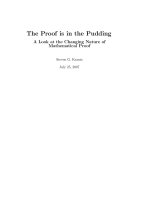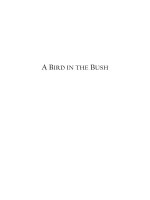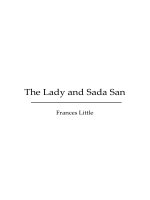a dictionary of colour a lexicon of the language of colour
Bạn đang xem bản rút gọn của tài liệu. Xem và tải ngay bản đầy đủ của tài liệu tại đây (1.02 MB, 528 trang )
A LEXICON OF THE LANGUAGE OF COLOUR
A DICTIONARY OF
COLOUR
IAN PATERSON
Inside front cover
A LEXICON OF THE LANGUAGE OF COLOUR
A DICTIONARY OF
COLOUR
IAN PATERSON
First published by Thorogood Publishing Ltd
2003. First paperback edition 2004.
Thorogood Publishing Ltd
10-12 Rivington Street
London EC2A 3DU
Telephone: 020 7749 4748
Fax: 020 7729 6110
Email:
Web: www.thorogood.ws
© Ian Paterson 2003
All rights reserved. No part of this publication
may be reproduced, stored in a retrieval system
or transmitted in any form or by any means,
electronic, photocopying, recording or
otherwise, without the prior permission of
the publisher.
This book is sold subject to the condition that
it shall not, by way of trade or otherwise, be
lent, re-sold, hired out or otherwise circulated
without the publisher’s prior consent in any
form of binding or cover other than in which it
is published and without a similar condition
including this condition being imposed upon
the subsequent purchaser.
No responsibility for loss occasioned to any
person acting or refraining from action as a
result of any material in this publication can
be accepted by the author or publisher.
A CIP catalogue record for this book is
available from the British Library.
ISBN 1 85418 375 3
Designed and typeset by Driftdesign.
Printed in India by Replika Press.
Special discounts for bulk quantities of
Thorogood books are available to
corporations, institutions, associations and
other organisations. For more information
contact Thorogood by telephone on
020 7749 4748, by fax on 020 7729 6110, or
email us:
colour
love
the most
The purest and most
thoughtful minds are
those which
JOHN RUSKIN (1819-1900)
Blank
Contents
Introduction 1
References and abbreviations 6
Dictionary entries 8
Appendix one: Colour phrases 433
Appendix two: The colours in alphabetical order 455
Appendix three: The colours in colour order 480
Appendix four: Adjectives of colour 505
Blank
1INTRODUCTION
Introduction
Any attempt to define any particular colour merely by means of words is doomed
to failure. We can illustrate the general nature of any particular colour by reference
to an object having the same quality (which begs the question) or by reference
to its wavelength (which is of interest only as a matter of physics) or by reference
to another colour (which becomes circular). For example, ‘Purple’ is defined in
the new Oxford Dictionary as ‘a colour intermediate between red and blue’. Blue
is defined as ‘a colour intermediate between green and violet’ and violet is ‘a
bluish-purple colour’.
This work variously employs each of the above methods, but not with a view to
providing definitions of colours. The vocabulary of colour is far too imprecise to
make that objective a realistic one. The best way to indicate the ‘meaning’ of a
particular colour word is to display its actual colour. Many works have embarked
on that task including, in particular, Maerz and Paul (A. Maerz and M. R. Paul, A
Dictionary of Color 3rd Edition, New York, McGraw Hill, 1953). However, there
is an infinite number of colours and shades, hues and tints (some suggest as many
as 16 million) so that it would obviously not be possible to provide each of them
with a distinct name. Furthermore, those colour descriptions which do exist do
not have a sufficiently exact meaning to enable any colour to be determined with
precision. No colour description in word form can convey the information necessary
to enable the precise shade and tone to be identified. Indeed, some colour names
included in this Dictionary have several different (and sometimes conflicting)
meanings. This is only partly due to the fact that our language is in a constant
state of flux. It is also as a result of the fact that the perception of colour is a highly
subjective matter. Colour is nothing without sight and sight is the only sense by
which we can experience colour. We experience most other stimulae through two
or more senses each corroborating the other. We can, for example, both hear and
feel sound and we can see, feel and smell heat. We do not have that support system
with colour. Furthermore, what I interpret as being green in colour may occur
to you as blue.
Rather, the purpose of this work is to provide a treasury of words of, or concerning
colour, and to do so in a way which is inviting enough to encourage readers to
dabble.
2 A DICTIONARY OF COLOUR
Single subject dictionaries are grossly under-utilised, particularly as an introduction
to the subject. All too frequently this powerful resource is dusted down and used
in a one-off search for a definition after which it is immediately returned to its
place on the shelf. A good dictionary should be regarded as a foreign land calling
out for exploration and to which each visit is a journey of discovery, each dictionary
entry drawing one onto the next, sucking in the reader and making it difficult for
him to leave. I hope that this work might serve just such a purpose and will attract
visitors to stay and explore rather than merely to pay a flying visit.
I would hope that this Dictionary, touching on the whole spectrum of colour
relevance, will serve as an invaluable resource for art students and students of
colour, although it is neither a technical exposition of the many facets of colour
nor a guide on how to use colour.
Much of what colour has to offer might appear to some of us as superficial and
even banal. It might be thought that colour merely constitutes an alternative to
black and white. Colour may merely be associated with fripperies such as cosmetics
and fashion or with football shirts, the colour of the car or decorating the hall.
Does colour really matter? Does it really deserve study and attention?
Well, yes it does. Not only is colour the stuff of art and a vital constituent of our
everyday lives, but without it the most important discoveries and advancements
of the 20th century would not have been possible. As Leonard Shlain in Art &
Physics, New York, Morrow, 1991 explains, colour has provided the key which
has made it possible for scientists to determine the elements of distant stars; to
verify that our universe is expanding; to understand electro-magnetic fields; to
penetrate the complexities of quantum mechanics and to work out the composition
of the atom.
Dabbling in this Dictionary will immediately indicate the important role which
colour performs in our everyday lives. Colour is used not merely to decorate or
to adorn. It provides us with a means of distinction. Colour is nature’s way of
helping animals to avoid predators; to attract mates; of showing when fruit is
ripe to eat or when it is rotten. Colours serve the everyday function of giving us
instructions in an effective and simple way – such as with traffic lights. Colours
provide a simple and immediate way to convey the degree or seriousness of
situations such as flood warnings, traffic congestion, danger and security alerts,
to highlight differences and to make it easier to assimilate information whether
in written form or on a computer or monitor. Colour is used as a means of
diagnosing illness or indicating the seriousness of a particular medical condition.
Doctors have, for example, recently discovered that the colour of the spit of patients
can show the severity of their lung disease.
3INTRODUCTION
In advertising and marketing, colour is used to grab our attention and to stimulate
us by reference to the many psychological and physiological responses to colour,
as well as the appeal which colour provides for our emotions. We all instinctively
appreciate the dimension which colour can bring to product packaging and which
it is difficult to create by any other means. Colour can serve to reinforce the identity
of products, trademarks, logos and brand images and to create pleasing or
favourable associations in the minds of consumers.
Colours are used to indicate those prisoners who are considered prone to escape;
to differentiate one team from another in all manner of sporting activities; to enable
us to play snooker and card games. Colour is used as a means of indicating status
– for example, purple for nobility – and colour has throughout time served as a
potent source of symbolism in all cultures.
In short, colour is a powerful shorthand for conveying ideas and information.
In deciding on the parameters of this work it soon became apparent to me that
I could not limit myself merely to words which indicate or touch upon colour.
Colour cannot exist without light. Hence, I have incorporated all the words I can
find which refer to light or illumination. That, of course, naturally leads onto words
of darkness and to words of shadow and obscurity, and thence to words indicating
markings or patterns, all of which I have sought to include. I have, however, stopped
short of including entries for animals, plants and flowers whose names include
a colour since there are too many of these. I have also held back from including
the plethora of fancy names created by paint manufacturers and others. Almost
all the colours in this vocabulary can be found in English dictionaries.
The extent to which colour occupies and influences us can be illustrated by
reference to the large number of common phrases referring to colour used in
daily speech, many of which are included in Appendix one.
I would hope that this work might also be used as a resource for wordsmiths,
crossword addicts and word game aficionados for whom Appendix two and
Appendix three with their lists of colours may prove useful. The Times Crossword
of Friday 22 October 1999, for example, had two consecutive clues:
• ‘Earthy colour of old church attracting note’; and
• ‘Red pigment in drops sprayed around house’.
Even the recognition that these clues indicate colourwords would not make it
easy to find the answers (ochre and rhodopsin).
4 A DICTIONARY OF COLOUR
This work also serves as an observer of the way colourwords are used in syntax.
Writers always need ideas and refreshment and it is hoped that this Dictionary
might help to provide that elusive spark of inspiration vital to keep the creative
process going, particularly for those writing on subjects such as art, design,
fashion, furnishings, make-up or gardening. Finding the precise colour adjective
where there are so many nuances, might be made easier by referring to the list
in Appendix three.
Colour is involved in everything we do during our working hours and even
invades our dreams. But what is colour? There have been many theories over
the centuries as to the exact nature of colour but none of them is adequate to
explain all aspects of what colour is. The position is further complicated by the
fact that the dynamics of surface colour are very different from those principles
governing coloured light.
Colour is the sensation resulting from the light of different wavelengths reaching
our eyes. The colour of any object is determined by the extent of the absorption
of photons by its atoms. A black object absorbs nearly all the light directed onto
it whereas a white object reflects most of that light. A coloured object reacts
selectively to light energy – it absorbs protons of some wavelengths and reflects
others. An object which is green in colour, for example, will absorb photons from
the red to yellow range of the spectrum and reflect (thus enabling us to detect
them) photons on the green to violet range. The selection process will depend
on the particular pigments contained in that object. Caretonoids, for example,
reflect long wavelengths and absorb short wavelengths, so as to produce an orange
or pinkish colour. Haemoglobin produces red. Anthocyanin produces the colour
of rhubarb and beetroot. Dyes and paints are based on this idea. Some dyes form
a new compound with the molecules of the subject matter they are being used
to colour.
It is my intention that this work with its panoply of colourwords will provide both
an instructive and an entertaining opportunity to appreciate the richness of colour
and its many diverse applications through the ages and across the disciplines.
The study of colour and colour theory involves reference to many fields of study.
A thorough investigation of the subject will involve an understanding of physics
and chemistry, biology, medicine, the art of healing, computer sciences,
mathematics, psychology, physiology, philosophy, literature, art; the history of
art, aesthetics, heraldry, lexicography and language. This short work refers in
some measure to each of these disciplines and many more, but concentrates on
the last of them in celebration of our magnificent language.
5INTRODUCTION
I owe a debt of gratitude to my wife Linda for her unswerving encouragement
and for indulging my obsession to write this Dictionary. My thanks also to Mark,
Emma and Odette Paterson, Robert Glick, Amanda Blakeley, Eddie Cohen and
Neill Ross for their enthusiasm and additional ideas.
Ian Paterson, April 2003
all
JOSEPH ADDISON (1672-1719)
speak
Colours
languages
6 A DICTIONARY OF COLOUR
References and abbreviations
Albers Josef Albers, ‘Interaction of Colour’ Yale University,
1975.
Ball Philip Ball, ‘Bright Earth. The Invention of Colour’,
Viking, 2001.
Chambers ‘Chambers English Dictionary’ W.R. Chambers and
Cambridge University Press, 7th Edition, 1988.
Fielding ‘A Dictionary of Colour’, 1854.
Gage A number of references to John Gage’s: ‘Colour and
Culture’ Thames and Hudson, 1993 and ‘Colour and
Meaning’, Thames and Hudson, 1999.
Maerz & Paul A. Maerz and M.R. Paul, ‘A Dictionary of Colour’, 3rd
Edition New York, McGraw Hill, 1953.
OED ‘The Oxford English Dictionary’, 2nd Edition, Oxford
University Press, CD Rom, 2002.
Partridge Eric Partridge, ‘Name into Word’, Secker and Warburg,
1949.
WWW or
‘World Wide Words , Editor Michael Quinion.
WW1 World War 1
WW2 World War 2
Obs. Obsolete
G Greek
L Latin
Blank
A
n aal
A red dye from the plant of the same name related to the madder plant (and a
useful word for word game players).
n abaiser
Ivory black.
n abozzo, abbozzo
An underpainting in one colour; a sketch.
c absinthe, absinth
The light green colour of the potent liqueur of the same name which was banned
in France in 1915 because of its effect on health and the performance of French
troops at the beginning of WW1. It continues to be banned in France and in the
US but is allowed in the UK where it has been imported since 1998. The liqueur
takes on a milky colour when water is added.
c acacia
A greyish or greenish yellow colour.
c academy blue
A mixture of viridian and ultramarine; a greenish blue.
8 A DICTIONARY OF COLOUR
ZYXWVUTSRQPONMLKJIHGFEDCBA
9ZYXWVUTSRQPONMLKJIHGFEDCBA
c acajou
A reddish-brown from the mahogany of the same name.
n accent colours
Highlights; sharp colours.
n accessory pigments
Those pigments in blue-green algae which in photosynthesis transfer their energy
to chlorophyll.
n accidental colour
The after-image temporarily fixed on the retina also referred to as ‘subjective
colour’. When the eye concentrates on one colour and looks away the comple-
mentary colour often appears as a false or accidental colour.
n accidental light
A term used in painting to indicate any light source other than sunlight.
n acetate dye
A type of dye (also called disperse) developed for acrylic fabrics.
a acherontic
Gloomy or dark. Derived from Acheron which according to Homer was one of
the rivers of Hell – its waters having a deathly foreboding appearance. ‘Stygian’
(in reference to the infernal River Styx of Greek mythology) has a similar meaning.
a achlorophyllaceous
Colourless.
n achroglobin
A colourless pigment in some molluscs.
n achromate
A person who is unable to detect colour.
a achromatic
Free from colour, uncoloured, colourless. From the Greek
a- without and chroma-colour.
adjective a
adverb adv
a colour c
noun n
prefix pr
suffix su
verb vb
10 A DICTIONARY OF COLOUR
n achromatic colour
A colour, such as white, black or grey, which lacks hue. White, black and grey
are technically not regarded as colours having regard to the absence of hue.
a achromatistous
Colourless.
n achromatopsia, achromatopsy
The inability to see colours: a severe form of colour-blindness.
a achromic
Free from colour; without normal pigmentation. See achromatic.
a achromous
Colourless.
a achroous
Colourless – why should there be so many words to describe such a nondescript
condition when the English language is so impoverished in the variety of words
which describe colours?
n acid colours
Colorants such as chromotrope, chrome brown, chromogen, acid green and
alizarin yellow used as dyestuffs.
c acid-drop yellow
A medium yellow.
c acid green
A bright green.
a acid-washed
Describing fabric which has been bleached to give the appearance of being worn
or faded; particularly denim used for jeans – referred to as ‘distressed denim’.
Similar results can be obtained by other processes to produce fashion items
referred to as ‘stonewashed’, ‘bleached’, ‘prewashed’ or having an ‘antique look’.
c acid yellow
A medium yellow.
11ZYXWVUTSRQPONMLKJIHGFEDCBA
c acier
Steel-coloured; grey.
c Ackermann’s Green
A yellowish green.
c acorn brown
The brown colour of the acorn; also simply referred to as ‘acorn’.
c acridine yellow
A yellow coal-tar dye also used as an anti-bacterial agent.
n acritochromacy
Colour-blindness.
a acronichal
Occurring at sunset or twilight.
n acrylic
Water-based paint consisting of an emulsion with particles of plastic resin
suspended in water and pigment to provide colour. Acrylic paint dries rapidly
and is very durable. An alternative to watercolour and oil paint but less popular
than it was in the 1960’s and 70’s. The word derives from ACRYLate resIN which
is the binder used to hold the pigment together. Almost all acrylic paints are
synthetic. They include colours such as benzimidazolone orange, dioxazine
purple, indanthrene blue and quinacridone red.
n acyanoblepsia
The inability to see the colour blue.
c Adam blue
A greeny blue.
n additive colour
The result of mixing coloured light (as opposed to pigments such as paint and
ink) so that, for example, mixing red, green and blue (called ‘additive primaries’
or additive primary colours) in colour television broadcasting or on a colour
monitor will produce white light by the additive process. The process of mixing
light of two different colours always produces a result which is lighter than its
two forebears. See subtractive process.
12 A DICTIONARY OF COLOUR
n additive primary colours
Red, green and blue. See primary colours.
n adjacent colours
Colours which are next to each other on the colour wheel or on a painting or
design etc. The placement of two colours next to each other often results in both
hues taking on a different appearance so that, to take one example, red next to
yellow makes the red turn towards purple and the yellow appear green.
c adobe
Pinkish-red; probably so called after the sun-dried bricks of the same name used
in Latin American countries; also ‘adobe red’.
vb adorn; to
To decorate or beautify something often by means of colour. Synonyms include
decorate, beautify, grace, emblazon, embellish, ornament, deck, bedeck, enhance,
enrich, festoon, elaborate, dress, bedaub, beset, deck out, bedizen, trim, gild, trap
out, accoutre, prettify, spruce up, rig out, trick out, garnish, crown, paint, colour.
c Adrianople red
A red colour also called Turkey red.
a adularescent
Bluish. According to Stormonth’s English Dictionary 1884 – having the whitish
sheen of moonstone found on Mount Adula in Switzerland.
a adumbral
Shadowy.
n adumbration
Shading.
c adust
A scorched brown colour.
n advancing colours
Colours in the range of yellow to red which when applied to a surface make it
appear more prominent or as if it is advancing towards the viewer. See also
receding colours.
13ZYXWVUTSRQPONMLKJIHGFEDCBA
pr aene- (L)
Bronze.
a aeneous
Having the colour or lustre of brass.
a aeruginous
Having the colour of verdigris or copper-rust.
pr aethio, aetho, aethrio (G)
Bright, firy.
c african violet
The pinkish violet of the flower of the same name.
adv after dark
An ambiguous expression meaning after it has become dark rather than after it
has ceased to be dark.
n afterglow
The glow remaining after the disappearance of light, in particular, in the sky after
sunset.
n after-image
The sensation of colour remaining after the stimulus has ceased where, for
example, one stares at an image or object and then looks away to a white surface.
The shape remains fixed for a while. Often, the colour of the original image is
found to be complementary to the after-image. See also complementary colours
and accidental colour.
n Agent Orange
The extremely toxic defoliant used by the US during the Vietnam
war. Named not by virtue of the colour of the substance but
in reference to the orange stripe on its container.
pr aglao- (G)
Bright.
adjective a
adverb adv
a colour c
noun n
prefix pr
suffix su
verb vb
14 A DICTIONARY OF COLOUR
adv aglow
In the glow of a warm colour.
c Air Force blue
A dark blue colour. The blue adopted by the Royal Air Force in 1919.
c air-blue
Used to describe the light blue of the thrush egg.
n airbrush colours
Pigments suitable for use in airbrushes, that is, instruments employing compressed
air to spray paint.
pr aitho, (G)
Burnt brown.
a aithochrous
Reddish-brown.
a alabaster
Akin to alabaster in its whiteness and the smoothness of its texture. Shakespeare’s
Richard III, Act 4 Scene 3 ‘Gentle babes girdling one another Within their alabaster
innocent arms’.
n alacktaka
A red lacquer used in India as a cosmetic for the lips.
pr alb- (L)
White.
n albatross
The path by which many English words have journeyed to the current vernacular,
with their multifarious mutations and transformations, is a fascinating study.
Albatross is probably a mistaken version of ‘Alcatraz’ a Portuguese word for the
sea-fowl (and the origin of the the name of the prison island off San Francisco).
Curiously, although the Alcatraz was black in colour the word mutated to ‘albatross’
to describe the white petrel of Coleridge’s Ancient Mariner gaining credibility
on its journey from the ‘alb’ prefix meaning white.
15ZYXWVUTSRQPONMLKJIHGFEDCBA
n albedo
Whiteness especially in astronomy in reference to the reflection of light emanating
from a planet.
n albescence
A medical condition where the skin goes white through being kept in the dark
for a sustained period.
a albescent
Becoming white.
a albicant
Growing white.
n albication
The process whereby white spots or bands develop in plant foliage.
a albiflorous
White-flowered.
n albino
A person or animal having no colouring pigment in the skin, hair or eyes; plants
whose leaves do not develop chlorophyll. Hence, ‘albiness’, a female albino.
a albinotic
Having the characteristics of an albino.
n albocracy
Government by white people; see also chromatocracy.
n alcanna, alcana
The reddish orange body dye from the Oriental plant of the same name which
is of the same family as the European alkanet plant.
n aldehyde green
A green dye also referred to as emeraldine.
16 A DICTIONARY OF COLOUR
c alesan
A light chestnut colour.
n alexandrite
A valuable gemstone named after Tsar Alexander II of Russia. Alexandrite is green
in colour but appears columbine-red in artificial light. It has colour shifts from
green to orange-yellow to red according to the crystal direction.
c Algerian
A yellowish brown.
c Alice blue
US term for a greenish-blue after Alice the wife of Theodore Roosevelt. As AliceBlue,
one of the 140 colours in the X11 Color Set. It has hex code #F0F8FF.
n alizarin, alizarine
A synthetic red dye identified in 1820 and replacing the natural red dye from the
root of the madder plant. It produces crimsons, greens and blues and other shades
depending on the mordant used, in particular, alizarin crimson. Produced
artificially since 1868 after which vineyards began to replace the redundant madder
fields of Europe. This was the first natural pigment to be made synthetically. Alizarin
dyes replaced aniline dyes but were themselves replaced in 1958 by quinacridones
which have greater lightfastness.
c alizarin crimson
A bluish-red serving as a substitute for rose madder. See alizarin.
n alkali blue
A class of blue pigment with a very high tinting quality used in making printing
inks.
n alkanet
An ancient red or orange dye from the roots of the Mediterranean plant of the
same name and of the same genus as the alcanna. Also called ‘anchusa’. See
henna.
n alkannin
A natural bronze-coloured pigment.
17ZYXWVUTSRQPONMLKJIHGFEDCBA
n alkaptonuria
A rare inherited disease in which urine and ear wax when exposed to the air
turn black or red depending on what food the subject has been consuming.
n alkyd
The group of synthetic resins used in manufacturing paint and possessing good
colour retention and durability; ALcohol+aCID= ALCID or ALKYD; hence
‘alkyd paints’.
n alla prima
The method of painting where the work is finished at one session and without
any preliminary underdrawing or underpainting.
a allochorous, allochroous
Multicoloured or changing colour.
a allochroic
Changing in colour.
a allochromatic
Referring to a change of colour; as regards minerals, having no colour.
n allura red AC
A red food additive used typically in cakes and biscuits (E129).
a all-white
‘all’ is often used in conjunction with a particular colour to indicate an absence
of any colour other than the one indicated.
c almagra
Deep red ochre found in Spain.
c almond
Pink or yellowish-brown as in almond blossom; sometimes
the greyish-green colour of the underside of the leaves of the
almond tree. Used to describe a variety of colours.
n almond black
A black pigment.
adjective a
adverb adv
a colour c
noun n
prefix pr
suffix su
verb vb









